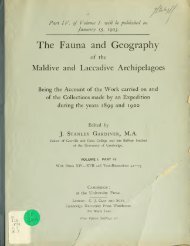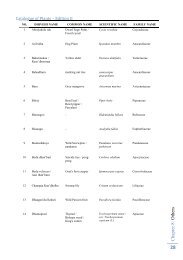Download - WordPress – www.wordpress.com
Download - WordPress – www.wordpress.com
Download - WordPress – www.wordpress.com
You also want an ePaper? Increase the reach of your titles
YUMPU automatically turns print PDFs into web optimized ePapers that Google loves.
638 R. C. PUNNETT.The nuchal skeleton is strongly developed, occupying a large portion of a transversesection in the region of the proboscis stalk (PL XLI. fig. 9). The keel is strongly developedbut much blunted, its side to side diameter being greater than the dorso-ventral one.The pericardium is provided with two small " auricles" reaching forward about -^ mm.from the main structure on either side.Collar. The epithelium of this region is high and fairly well provided with gland-cells.The posterior part of the collar on either side of the circular furrow is characterized by amore highly glandular zone. In the preserved specimens this region is somewhat paler incolour than the rest of the collar. The nerve fibre layer is distinct, whilst, as in theproboscis, the basement-membrane is thin. There is no layer of cu-cular muscles outside thelongitudinalmusculature.The collar coelom is entii-ely filled by longitudinal muscle fibres and connective tissue,Avith the exception of a small space round the opening of each of the collar funnels. Thedorsal septum is <strong>com</strong>plete throughout the entire length of the collar. The ventral septumis lacking only at the extreme anterior end (PI. XLI. fig. 10).The median nuchal skeleton is long whilst its cornua are exceedingly short (PI. XLI. fig. 10),a feature in which this genus differs markedly from the remaining members of the family.The cornua embrace nearly f of the total cii'cumference of the oesophagus.The collar cord exhibits a well-marked anterior and a smaller posterior neuropore. Theanterior neuropore especially reaches some way dov*Ti into the collar (PL XLI. fig. 10).Towards its hinder limit it be<strong>com</strong>es somewhat separated off fi-om the nerve cord on thedorsal surface of the lattei-. It is lined with a definite epithelium somewhat glandular andrichly provided with cilia. The nerve cord itself is quite solid and is almost entirely surroundedby a layer of nerve fibres (PL XXXVIII. fig, 23). In its hinder portion it shews awell-marked ridge projecting up towards the dorsal septum. This ridge is filled with cellscontaining a yellowish-brown pigment. These cells reach a little way into the nerve cordand similar cells are also to be found in the perihaemal spaces (PL XXXVIII. fig. 23).Pigment has previously been described by Spengel ('93, p. 134 and Taf 7, figs. 2, 12, 14)in the collar cord of Balanoglossiis apertas. Without going so far as Willey ('99, p. 316)in claiming that the dorsal roots are homologues of the vertebrate pineal eyes it is yetconceivable that these aggregations of pigment may serve for the perception of light rays.Besides this small dorsal ridge there occurs no representative of dorsal roots in W. bisulcata.From the anterior part of the collar cord passes off on either side a well-marked nerveto the layer of nerve fibrils beneath the oesophageal epithelium. These I have termed theoesophageal nerves (PL XLII. fig. 16, on.).With regard to the histology of the collar cord it may be stated that giant cells, suchas Spengel ('93, p. 609) has described for several species of Enteropneusts, are absent.Certain of the ganglion cells near the dorsal surface attain a somewhat larger size, butthis does not exceed 20—25 fi. Faint vestiges of the remains of cavities in the cord arevisible here and there under a high power. The pigment referred to above is found alongthe whole length of the cord.The perihaemal spaces are well developed and ventrally contain transverse muscle fibres.They do not <strong>com</strong>e into contact with one another until just in front of the point wherethe cornua of the nuchal skeleton diverge. Anterior to this they are widely separated bythe stomochord.






